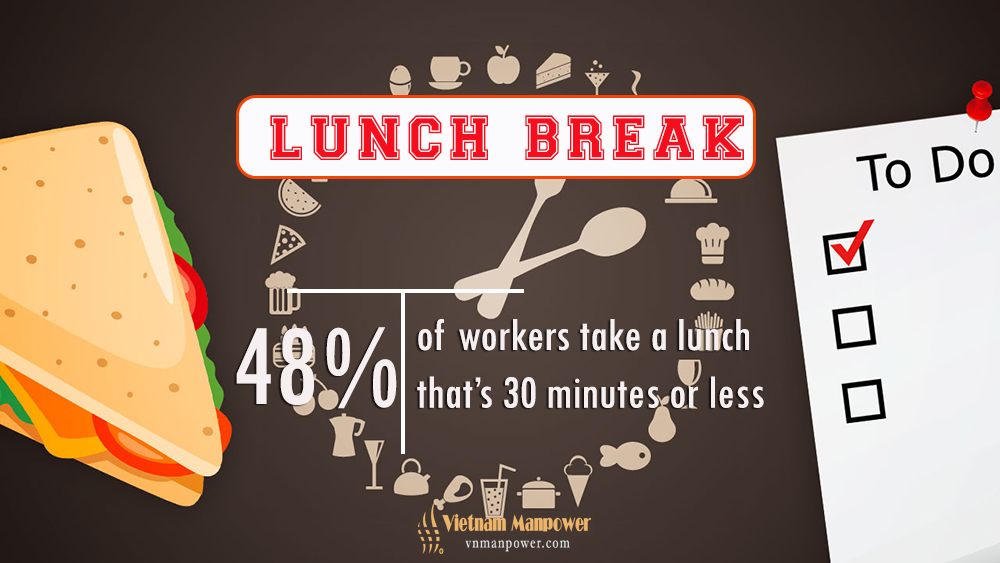Commonly, the lunch break time varies by the business nature and the arrangements in place within the organization. For instance, smaller businesses mayn’t have enough employees to cover lengthy lunches, so will opt for shorter ones. Some employees working in flexible time may lunch shorter in favor for leaving the workplace earlier.

THE ONE-HOUR LUNCH BREAK
Many companies believe that an hour for lunch is good for both the business and the employee. By taking such a long break to eat lunch, even leave the workplace to go for a walk, do some shopping, etc., it will leave the worker recharged and raring to go again. Some people even argue that when employees take an hour for lunch, they are more likely to make healthy food choices as they have more time to devote to it. This can help boost energy levels and raise work productivity. Because many businesses don’t pay their workers for their lunch hour, it makes sense to take the break and not be guilty about it.
THE HALF-HOUR LUNCH BREAK
Other companies argue that half an hour is enough to devote to lunch. Some workers may value this arrangement, too because they can leave the workplace half an hour earlier, or take two small rests in the morning or afternoon. In some workplace environments where there are no other shops, facilities, etc, nearby, there may not be enough to occupy an hour.

Still, the disadvantage of shorter lunch breaks is that employees may tend to eat at their desks. This will make it more difficult to switch off from work and work-related distractions, and may decrease productivity later in the afternoon. Workers need to take time away from desk to reenergize themselves, but this is less likely to happen with such a short lunch break. Another downside is that when being given to shorter breaks, workers may choose less healthy food options – for example, fast food, instant sugar boosts, which won’t sustain their energy levels throughout the rest of workday.
SO, HOW LONG SHOULD THE LUNCH BREAK BE?
So full hour or half-hour lunch break, which is better? Theoretically, the one-hour lunch break gives your workers the best opportunity to switch off and recharge their batteries for the afternoon. Yet, in reality, with higher workloads and pressures and different work arrangements, many employers restrict lunch breaks to half an hour. For any restrictions, employers and employees should discuss in good faith whether the restrictions are reasonable and necessary.
HOW TO DETERMINE WHAT BREAKS ARE GIVEN, WHEN AND FOR HOW LONG

You should consider those things:
• How long the worker’s work period is
• The nature of the worker’s work
• Any health and safety issues related to the work (fatigue, etc.)
• The time of day or night that the staff’s work period starts – can meal breaks match normal meal times, etc.
• The interests of the worker – for example, to allow enough time to rest, refresh and take care of personal matters
• The employer’s operational environment or resources – for example, does the employer need workers to take their breaks according to a roster or in stages, so as to continue production or services, or do all workers need to take their breaks at the same time?
WHAT TO DO WHEN YOUR WORKERS TAKE LONGER LUNCH BREAKS THAN STIPULATED?

People tend to relax during their lunch hour, and often exceed the regulated time duration. Before you take any action to this problem, there are a few things you should think about:
• Do these workers contribute a lot of value to your business? Rather, is allowing them to have a good long lunch the least you can do to show them that you appreciate them?
• Do they take long lunch breaks every day? If so, do their long breaks interfere with their work productivity?
• Do these breaks interfere with your business?
• Do you normally account for your staff’s time?
Of course, if your employees take daily longer lunch breaks than stipulated that may become their bad habit, and their productivity is affected, one important action you should take is to give them and other employees some guides to help them keep track of time. For the best, these guides are given along with the regulation of lunch break time. Time management skills prove helpful in all walks of life.
• Wear a watch
• Stay with a disciplined group
• Watch the seniors (immediate bosses, team leaders)
• Avoid gossiping
• Avoid chatting and using social media too much













Replies to This Discussion